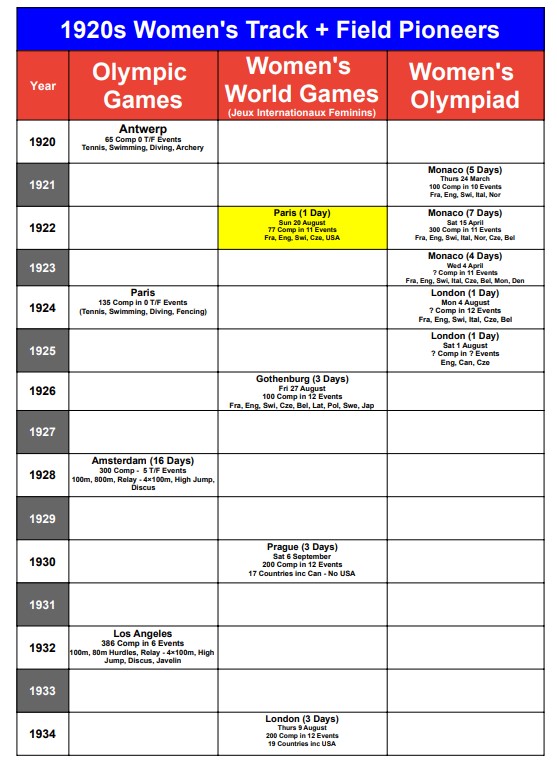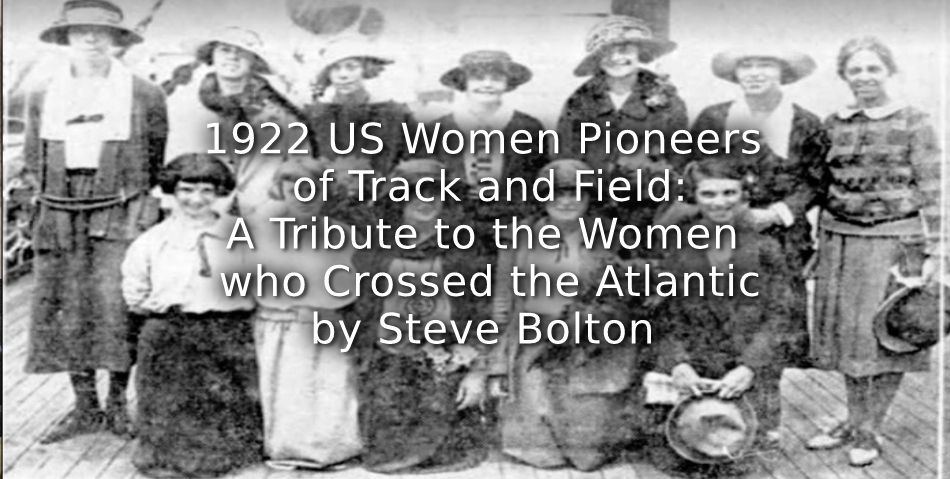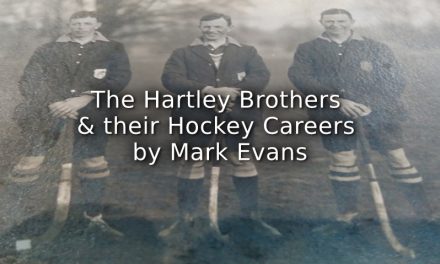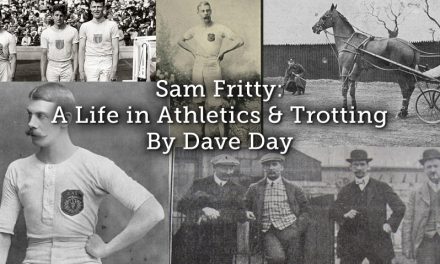
Coaches: Joseph D’Angola, Suzanne Becker, Dr Henry Eaton Stewart (MD)
Second: Ester Greene, Lucile Godbold, Nancy Voorhees, Lucile Voorhees, Frances Mead, Anne Harwick
Front: Janet Snow, Camelia Sabie, Elizabeth Stein, Maybelle Gilliland, Kathryn Agar, Maude Rosenbaum
Source: Gallica.bnf.fr/Bnf
Pioneering Women Athletes
100 years ago during the Autumn/ Fall of 1922 two groups of women athletes made the long Atlantic Crossing by sea to change history for women. In September 1922 this was the world famous Dick Kerr Ladies football (soccer) team of Preston, England embarking on their groundbreaking US tour. However, several weeks earlier a small and relatively forgotten set of US women track and field athletes were embarking on a trip in the opposite direction in the adventure of a lifetime.
Here is a photograph of the US Athletics team in training at Stade Colombes, Paris in August 1922 (Team captain Floreida Batson is missing from the photo as she was injured). These plucky 13 athletes were in Paris to represent the US at a solely track and field competition organised on Sunday 22 August at Stade Pershing. Stade Pershing was a gift from the US to France and was named after US General Pershing. Apart from the hosts, France and the US, three other countries took part: England, Czechoslovakia and Switzerland. 77 women athletes took part in 11 events as part of this one day event.
It is important to remember that women track and field athletes were not allowed at the 1920 Olympic Games in Antwerp or the 1924 Olympic Games in Paris. However, a breakthrough was made in 1928 at the Amsterdam Olympic Games where five extra track and field events were added to the existing provision for women athletes: 100m, 800m, Relay – 4×100m , High Jump and Discus. This was an important statement by the pioneering US women track and field athletes who made the long, eight day atlantic crossing to take part in the first of the Quadrennial Women’s World Games.
1922 – The Dick Kerr Ladies Football Tour to USA

Dick Kerr Ladies Looking Magnificent
Source: Lizzy Ashcroft Collection
9 Games – 3 Wins, 3 Draws, 3 Losses
The story of the Dick Kerr Ladies tour to the USA is celebrated in Gail Newsham’s Book: “In A League of Their Own”. It is quite a story. The Dick Kerr Ladies boarded the boat to Canada on Friday 15 September and did not dock back into Liverpool until Friday 17 November. When the Dick Kerr Ladies arrived in Quebec in September they were met by a US representative with news that the Dominion FA in Canada had refused permission for them to play. A hastily arranged tour playing against men’s teams in the USA was arranged. The games appear to have been quite competitive with the Dick Kerr Ladies captain Alice Kell reporting that the violent charging which was part of US soccer at the time was put aside for the mixed games. The first 7 games took in New Jersey, Rhode Island, Washington DC and New York City @ 2 and Massachusetts @ 2. These were completed by Sunday 15th October. Before setting sail for home on Thursday 9 November they had just two remaining games, one in Baltimore and one in Philadelphia. When they arrived back on Friday 17 November after 8 days aboard the White Star Liner Adriatic they had some tall tales to tell.
1922 Pennsylvania Railroad YWCA Relay Team

L-R: Helen Bakey, Kitty Lentz, Helen Muir, Betty Schenkel
Pennsylvania Railroad System – Philadelphia General Offices
Source: Muncie Evening Press 1923
Relay Race – Penn Railroad YWCA vs Dick Kerr Ladies – Dead Heat
On Saturday 4th November 1922 four employees of the Pennsylvania Railroad Company had a date with destiny. Helen Bakey, Kitty Lentz, Helen Muir and Kathryn Brown (3 pictured above in 1923) were invited to race 4 of the Dick Kerr Ladies in a 400/440? Yard Relay before the Dick Kerr Ladies football (soccer) match against the male Phillies FC. The Dick Kerr Ladies who ran were: Molly Walker, Lily Parr, Jenny Harris and Florrie Haslam. The Philadelphia Inquirer printed a lengthy and detailed match report about the football match. The newspaper also recorded that “after an exciting race it was called a dead heat”. Two weeks later the Chicago Tribune printed pictures of the Dick Kerr Ladies race team and also recorded the result as “tied”.
1923 One Year after their Famous Race
The 1923 Muncie Evening Press photo above is accompanied by an interesting article about the Railroad Company’s sports and athletic meeting where the picture was taken. The big “Pennsy” regional centres of Pittsburg, Chicago and St Louis apparently blamed their previous defeat in running on “wind catching bloomers”. The Philadelphia ‘girls’ were appearing for the first time in ‘almost weightless running trunks’ and the paper was happy to report that there were no negative comments that the girls attire was “unsuited or immodest” amongst the vast crowd of 40,000 spectators.
The race against the Dick Kerr Ladies was not the only race prior to a football (soccer) match in which the Penn Railroad YWCA team took part. In March 1923 the Penn Railroad YWCA took on a Baltimore relay team before a football match in Baltimore. This time, the best Philadelphia athlete Betty Schenkel was part of the team instead of Kathryn Brown. Interestingly, after tying with the Dick Kerr Ladies a year earlier the Penn Railroad YWCA team lost the 440 yd relay to a recently put together Baltimore team.
Kitty Lentz – Philadelphia Athlete

“Meet the Car Service team, champions of the Philadelphia Manufacturer’s Cage League
These fair maids won five straight games in the girls’ section of the league
and took the first half of the schedule with a 1000 per cent”
L-R: Charlote Walton, Kitty Lentz, Edith Wright, Eleanor Eyre, Betty Schenkel(C), Isabel Isinger
Source: Philadelphia Inquirer 192
Kitty Lentz – Runner and Basketball Player
Kitty appears regularly in the early 1920s as part of the local athletics and basketball scene. I think this picture gives some idea of the general sports outfit for women of the time and just how impractical it would have been for track and field events.
1920s “Doit-on Encourager Les Sports Féminins?”

Le Miroir Des Sports
Source: Lizzy Ashcroft Collection
“Should One Encourage Women’s Sport?”
This 1926 edition of the magazine Le Miroir Des Sport asks a fundamental question which was being seriously debated at the time. It is important to show the context of the 1922 tours to show just how difficult things were for pioneering women athletes in this era. The Olympic Movement grudgingly allowed women to compete in 5 track and field events in the 1928 Olympics in Amsterdam. This was after years of pressure and organised women’s track and field events led by the pioneering feminist and sports advocate Alice Milliat. The male English Football Association imposed its extremely influential 50 year long ban in December 1921 against women playing football on affiliated pitches. This may have been an extra stimulus for the tour to Canada and the US. Alfred Frankland, the Dick Kerr Ladies manager, reported at the end of the tour just how disappointed he was with the Dominion FA for following the English lead.
1920s Track + Field Overview

Source: Collated from Various Sources by Author
Author’s Note
As women’s track and field athletics grew in the 1920s many events took place in Europe which were an alternative to the Olympics for women. In my ‘overview’ I have referred to the two main alternative options for women athletes as the ‘Women’s World Games’ and the ‘Women’s Olympiad’. The term ‘olympics’ was used liberally in the media to describe many athletic events involving women which are not now classified as ‘Olympic’. There are other events which I haven’t included which were less international such as the ‘Fete Du Printemps’ in Paris, the visit by Plymouth Ladies Football Club/ combined athletics, the ‘Daily Mirror Trophies’ and the annual Czechoslokian athletics tournaments. The team from England appears to have been mostly made up of London based athletes and so I have used England, rather than Great Britain or the United Kingdom as the country designation.
I think that it is very important to note that the first ‘Olympiad’ in Monaco was set up as a women’s Olympic Games by Alice Milliat to attempt to break down the intransigence of the establishment. I would in no way wish for my attempted overview to airbrush this important point.
Women’s Olympiads 1921 – 1925

1922 Ivy Lowman in Monaco
Source: Lizzy Ashcroft Collection
Femina Sport of Paris
In 1912 a very important event took place in Paris. Germaine Delapierre, Suzanne Liébrard and sisters Jeanne Brulé and Thérèse Brulé helped form Femina Sport. By 1925 there were over 1,000 paid up female members and other similar organisations such as Academia, En Avant, Les Hirondelles and Les Sportives were thriving. Femina Sport even had its own stadium: Stade Elisabeth. Stade Elisabeth is located in the South of Paris near to the Porte D’Orleans and is still in existence today. In 1925 as well as a large covered stand the stadium had a shooting range, a gymnasium and a canteen. Women’s track and field events were a regular and important feature so during the early 1920s France could field a team of women athletes well versed in competition. The annual trip to Monaco (1921, 1922 and 1923) was a big signal that women track and field athletics should be included in the ‘main’ Olympic Games.
In the early 1920s there was also a thriving athletic scene for women in England around the London Olympiades AC, Middlesex Ladies AC, Manor Park AC and others based in or near London. The top English athletes of the day were Hilda Hatt, Mary Lines, Ivy Lowman, Nora Callebout, Florence Birchenough, etc and they were successful in many of the European events. The Daily Mirror and other newspapers sponsored interclub events in England and eventually offered to host the fourth International Women’s Olympiad in 1924 at Stamford Bridge. To say that the French were not impressed with the organisation and refereeing of the event would be an understatement.

Source: Lizzy Ashcroft Collection
There was one final Women’s Olympiad in 1925 in London where unsurprisingly the French did not take part. In 1926 the United Kingdom went into turmoil as the General Strike took place in early May. The late 1920s were therefore not a good time for international women’s track and field events, although the Second World Women’s Games took place over three days in Gothenburg, Sweden. (England won with 50pts over France with 27pts, Sweden 20pts, Czechoslovakia 19pts, Japan 18pts, Poland 7pts and Latvia 1pt).
1922 Paris – The Inaugural Women’s World Games

US Track and Field Athletes Training for Paris
Kathryn Agar, Janet Snow, Elizabeth Stein, Camelia Sable, Floreida Batson (captain), Maybelle Gilliland
Source: New York Daily News July 1922
“America Pins Her Hopes on These Girl Athletes”
There were attempts to raise money to fund the tour but this came to no avail with the athletes having to fund their own trip. The US press stated that girls boarding schools and colleges held two national meets in the East and West to pick the 13 girls. Most were ‘boarding school misses’ and great interest was taken in the fact that Nancy Vorhees was only 15 years old. Maude Rosenbaum did not go on the boat as she was already in Paris training. The Coach, Physician and ‘moving spirit’ of the trip was Dr Harry Eaton Stewart. Mr Joseph D’Angola accompanied the trip as a member of the American Delegation of the International Committee. Suzanne Becker of Oaksmere School (which provided two of the athletes) went as the female coach. The wives of Mr Stewart and Mr D’Angola accompanied their husbands. The mothers of Francis Mead and Floreida Batson went on the trip as well. There were many newspaper reports and pictures about the trip. The word ‘olympics’ was used quite frequently in the media of the day.
1922 – USA win 4 Gold Medals at Inaugural Women’s World Games

Source: Various online/newspaper
Team USA Second After England
Although the first Women’s World Championships only took place over one day in August 1922 it was the first in a groundbreaking quadrennial series of women’s track and field events. As has been noted, France and England had strong women’s teams but the USA team performed extremely well and came away with 4 Gold Medals, 1 Silver Medal and 3 Bronze Medals. The team totals were as follows: England 50pts, USA 31pts, France 29pts, Czechoslovakia 12pts and Switzerland 6pts.
There was some controversy in the relay and the US team were not happy with Monsieur Emile Antoine the French referee. The US team placed 2nd in the relay but because the Czechoslovakia team interfered with the French team they were demoted to 4th place. This did not affect the overall standings.
Dr Henry Eaton Stewart commented that his team were mostly ‘school girls’ who were pitted against ‘trained and seasoned athletes’ so their success was remarkable. Only 9 girls returned immediately which tends to confirm the idea that most were of independent means.
The US Women Athletes were Celebrated in French Press

Louise Voorhees, Elizabeth Stein, Lucile Godbold, Camelia Sabie
Source: Gallica.bnf.fr/Bnf
US Press Celebrating the Returning Heroes

One of Many Celebratory US Articles
Source: New York Herald, August 1922
Gold Medal Athlete Camelia Sabie – “She Won for US”

An Example of US Pride
Source: Illinois Freeport Journal-Standard
19 Year Old Camilia Sabie Embodying the American Dream
This lengthy syndicated article went to great lengths to point out Camelia’s origins as part of an Italian immigrant family in a poor part of Newark, New Jersey. Her mother, Angelica (in the picture above with Camelia) spoke no English but was happy to extol her daughter’s virtues through an interpreter. She described her daughter as a ‘tomboy’ who ran around with the boys climbing trees in preference to playing with dolls. She then hastily added that Camilia helped around the house and could cook. She proudly adds that her famous daughter was going to take up a teaching position. This was the case and after qualifying Camelia taught physical education through to at least 1963. Newspaper articles claimed that she was not interested in Hollywood as she would rather teach.
Lucile Godbold “Miss Ludy” of Estill, South Carolina

Lucile Godbold in Action
Source: The Standard Union, September 1922
‘As glad to see the Statue of Liberty as a South Carolina mule is to see Sunday”
Lucile Godbold came back to an amazing reception. She was quoted as saying that she was ‘as glad to see the Statue of Liberty as a South Carolina mule is to see Sunday’. There is a sign in her honour in her native town of Estill. She taught physical education at Columbia College for 58 years and was affectionately known as ‘Miss Ludy’. There is, to this day, an annual flag football game in her honour played by students at the College.
US Track and Field Pioneers

Embarking on the Trip of a Lifetime
Source: Asbury Park Press August 1922
Conclusion – Women’s Athletics in 1920s
As well as Lucile and Camelia, others from the trip went on to long careers in athletics. Joseph D’Angelo had a long career in athletics administration and teaching and is celebrated by his alma mater. Maude Rosenbaum became a very good tennis player and had an eventful married life.
The New York Herald reported on 19 August 1922 that the “International Federation of Feminine Athletics” held its first congress in Paris. Alice Milliat was elected President and Suzanne Becker was made a permanent member of the Committee. Three key figures in the 1920s growth of track and field athletics were elected Vice-Presidents: Dr Harry Eaton Stewart of USA, Major WB Marchant of England and Dr M Jaro Trantina of Czechoslovakia.
Dr Harry Eaton Stewart continued for many years to fight for women’s athletics. He was a qualified Doctor and he worked at the New Haven School of Physiotherapy in Connecticut. As well as organising and encouraging the growth of inter-school and inter-college athletics meets for girls he was able to use the gravitas of his position to dispel the persistent myths that this kind of activity was harmful for girls and women. In his role as President of the National Women’s Track Athletic Association he had to negotiate a path for this nascent organisation in the face of the all-powerful Amateur Athletic Union. The New York Herald reported in 1923 that the AAU was trying to ‘get control of all sorts of sports’. It is perhaps time to recognise his important role.
Another incredibly important figure in the 1920s in England was Major WB Marchant. As was stated earlier the London Athletics Clubs pioneered organised athletics for women. Major Marchant was the Director of Physical Education at the Regent Street Polytechnic, London. Like Dr Stewart he used his position and gravitas to reassure the press and society in general that athletics was not harmful for women and that the safety of the athletes was foremost. In August 1922 he was elected as joint Secretary of the newly formed Women’s Amateur Athletic Association, together with Mrs S C Eliott-Lynn. (Mrs Eliott-Lynn was a well-known athlete and high jumper and later became a famous aviator). The WAAA had to steer through the ‘tricky waters’ of social acceptability in the 1920s. It needed sponsorship and support from powerful organisations such as the Daily Mirror. To this end pronouncements were made against women’s football and against running further than half a mile. When asked about tug-of-war the recommendation was that “only women in thorough training should take part in this kind of contest”. Major Marchant eventually became Honorary Secretary of the WAAA and gave many years of service. He was eventually presented with a silver cigarette box and case in 1929 when he stood down and Nora Callebout (now Nora Coates) was elected to replace him. It is perhaps time to recognise his important role.
I recently watched the film ‘Chariots of Fire’, an old favourite of mine which I hadn’t seen for many years. It is set in the run up to the 1924 Olympics which was held in France and despite the tremendous efforts of Alice Milliat and the women athletes continued to bar women from track and field. Perhaps it is time for a film reflecting the struggles of the women athletes in this era?
Article © Steve Bolton





